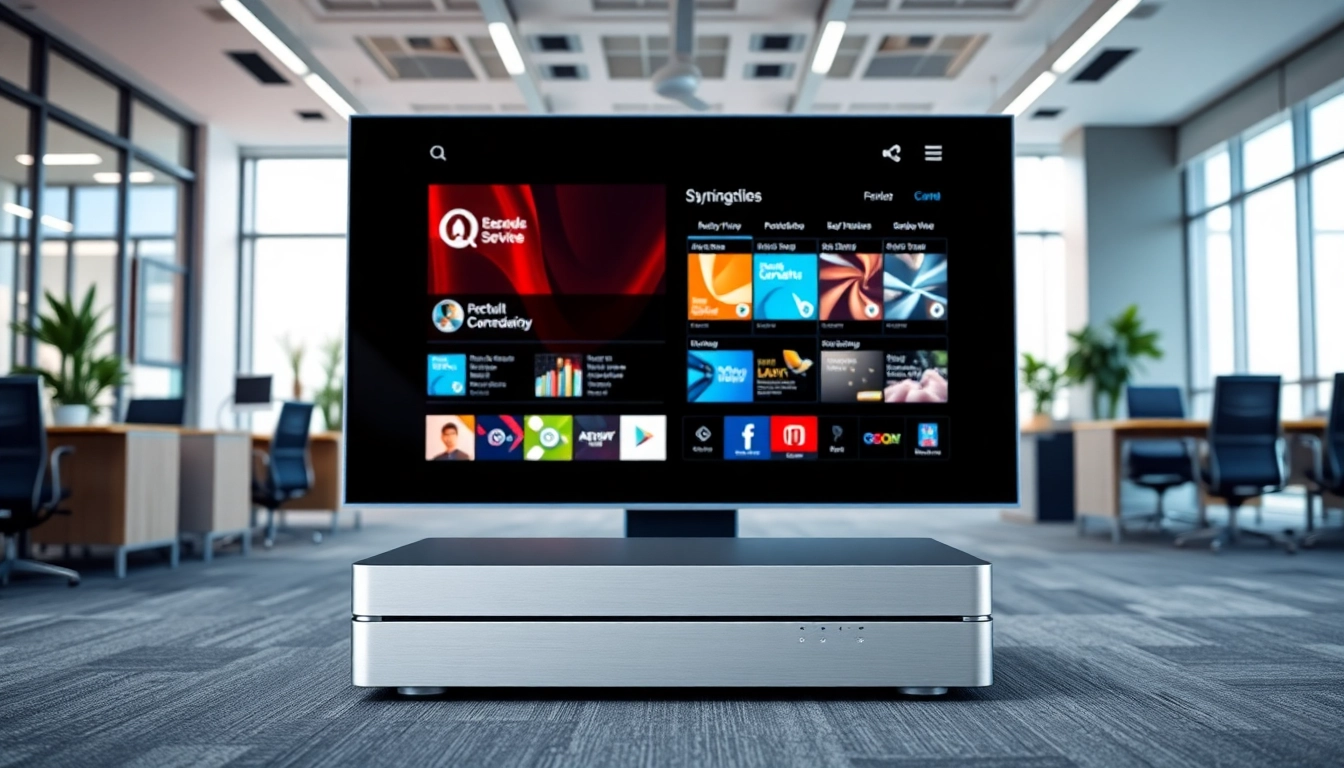
Understanding the Android digital signage player
Definition and Features
An Android digital signage player is a hardware device that utilizes the Android operating system to facilitate the display of digital content on various screens, including televisions, LED displays, and monitors. These players are equipped with a range of features designed to optimize visual communication in various environments, such as retail spaces, corporate offices, healthcare facilities, and public venues.
Key features of an Android digital signage player typically include:
- Compatibility with multiple content formats, including videos, images, and web pages.
- Access to a wide array of digital signage applications available on the Google Play Store, allowing users to customize their content management.
- Remote management capabilities via cloud-based software, enabling effortless control over content scheduling, updates, and deployments.
- Integration with social media platforms, allowing real-time content updates.
- Support for different display resolutions and aspect ratios, ensuring high-quality visuals across various screen sizes.
Advantages of Android digital signage player
The adoption of an Android digital signage player offers numerous advantages that position it as a preferred choice for businesses seeking effective communication solutions:
- Cost-Effective: Android digital signage players are generally more affordable than proprietary signage solutions, making them an economically viable choice for businesses of all sizes.
- User-Friendly: With an interface similar to other Android devices, users can quickly learn to navigate and operate the system without extensive training.
- Versatile: These players can be used for various applications, from advertising to informational displays, meeting the diverse needs of different industries.
- Regular Updates: The Android operating system is updated regularly, providing users with improved features and security enhancements.
- Scalability: Businesses can easily scale their digital signage network by adding more players without significant investment in new technology.
Popular Use Cases
The versatility of the Android digital signage player enables its application across various sectors, including:
- Retail: Stores can showcase promotions, new arrivals, and interactive content to engage customers and drive sales.
- Corporate: Businesses can utilize digital signage for internal communications, displaying information such as employee announcements, event calendars, and performance metrics.
- Healthcare: Hospitals and clinics can provide patients with important information regarding wait times, health tips, and directions within the facility.
- Education: Schools and universities can display schedules, announcements, and event information, enhancing the on-campus communication experience.
- Transportation: Airports and train stations can utilize digital signage for real-time updates on departures, arrivals, and other essential travel information.
Setting Up Your Android digital signage player
Hardware Requirements
Setting up an Android digital signage player involves ensuring you have the right hardware. Here are the key components you will need:
- Android Digital Signage Player Device: This could be a standalone device or integrated within an Android-enabled display.
- Display Screen: Choose a screen appropriate for your environment, considering size, resolution, and brightness for optimal visibility.
- Power Supply: Ensure a reliable power source is available to your signage player and display.
- Internet Connection: A stable internet connection, either Wi-Fi or Ethernet, is necessary for content uploads and remote management.
Software Installation Steps
To get your Android digital signage player operational, follow these software installation steps:
- Connect the Player: Connect the Android digital signage player to the display using an HDMI cable and plug it into a power source.
- Network Setup: Connect the player to your network via Wi-Fi or Ethernet to ensure it can access online content.
- Android Setup: Turn on the player and complete the initial Android setup process by connecting to your Google account and downloading necessary apps.
- Install Digital Signage Software: Download and install a digital signage application from the Google Play Store that best fits your content management needs.
- Configure Settings: Adjust the settings as required, including display options, content resolution, and playback scheduling.
Network Configuration Tips
Proper network configuration is crucial for the reliability of your Android digital signage player. Here are some tips to ensure smooth operation:
- Use a Strong Wi-Fi Signal: Place the player within range of a strong Wi-Fi signal or use a wired connection for better reliability.
- IP Configuration: Consider setting a static IP address for your player to avoid changing addresses which can affect connectivity.
- Bandwidth Management: Ensure adequate bandwidth is available, particularly if you plan to stream high-definition videos.
- Firewall Settings: Adjust firewall settings to allow necessary connections while maintaining security.
Content Management for Android digital signage player
Types of Content to Display
Content management is vital in maximizing the effectiveness of your Android digital signage player. Various types of content can be displayed, including:
- Videos: Engaging video content such as advertisements or promotional clips can capture viewers’ attention effectively.
- Images: High-quality images can be displayed to highlight products or services clearly.
- Textual Information: Important announcements, schedules, or promotional offers can be effectively communicated through well-designed textual content.
- Social Media Feeds: Integrating live feeds from platforms like Instagram or Twitter can foster engagement with your audience.
- Web Pages: You can display interactive web content to drive interest and provide additional information.
Scheduling and Playlists
Scheduling content and creating playlists are essential features of an effective digital signage solution. Here’s how to optimize this process:
- Content Calendar: Establish a content calendar to plan your displays around promotions, events, and seasonal changes.
- Dynamic Playlists: Create dynamic playlists that allow relevant content to be displayed based on the time of day or particular audience demographics.
- Rotation Strategy: Implement a content rotation strategy to keep the displays fresh and engaging, preventing viewer fatigue from repetitive content.
- Testing: Regularly review your playlists and schedules to ensure content is displaying correctly and making adjustments as necessary.
Dynamic Content Integration
Dynamic content integration adds a layer of engagement and relevance to your displays. Consider these strategies:
- Real-Time Updates: Incorporate real-time data such as weather updates, news tickers, or social media mentions to keep your audience informed.
- Interactive Content: Use touch screens or QR codes to create interactive experiences, encouraging audience participation.
- API Integrations: Leverage APIs to connect with other applications or services to pull in relevant content seamlessly.
- Data-Driven Content: Utilize analytics to determine which content performs best and adapt your displays accordingly.
Best Practices for Using Android digital signage player
Design Principles for Effective Displays
Designing effective displays requires adhering to certain principles to ensure clarity and engagement. Here are best practices to follow:
- Consistency: Maintain a consistent aesthetic across all displayed content, including colors, fonts, and logo usage to reinforce brand identity.
- Readability: Use large fonts and contrasting colors to ensure text is easily readable from a distance.
- Visual Hierarchy: Organize content into a visual hierarchy, placing the most important information where it can be easily seen.
- Avoid Clutter: Keep designs simple and uncluttered; too much information can overwhelm viewers.
- Use High-Quality Media: Utilize high-resolution images and videos to create a polished and professional appearance.
Engagement Strategies
To maximize audience engagement through your digital signage displays, consider these strategies:
- Interactive Media: Incorporate touch screens that allow users to interact with the displayed content, potentially leading to increased engagement.
- Call-to-Action: Include clear calls-to-action within your content, encouraging viewers to respond or engage further.
- Android digital signage player Features: Take advantage of the unique features available through your player to enhance the viewing experience—like animations or transitions.
- User-Generated Content: Encourage audience contributions, such as photos displayed on screens or hashtags promoted through displays, to foster a sense of community.
Measuring Success Metrics
Measuring the effectiveness of your Android digital signage player requires specific metrics to evaluate success. Here are key performance indicators (KPIs) to consider:
- Engagement Rates: Track audience interactions, such as the length of time spent viewing displays and responsiveness to calls to action.
- Content Performance: Analyze which content pieces generate the most engagement or conversions to fine-tune future displays.
- Audience Reach: Pay attention to foot traffic and observe fluctuations corresponding with specific content displayed.
- Data Analytics: Implement data analytics tools to gather insights on viewer behavior and demographics, refining strategies based on this data.
Troubleshooting Common Issues with Android digital signage player
Connectivity Problems
Connectivity issues can disrupt the functionality of your Android digital signage player. Here are ways to troubleshoot these common problems:
- Restart the Device: Often, simply restarting the player can resolve minor connectivity issues.
- Check Network Status: Ensure that your internet connection is active and stable, testing other connected devices if necessary.
- Inspect Cables: Check all physical connections, including cables, to ensure they are secure and undamaged.
- Update Firmware: Regularly check for firmware updates that may address connectivity concerns.
Content Display Issues
Issues with content not displaying correctly can arise and may be frustrating to manage. Follow these tips to address them:
- Content Format: Verify that the content uploaded is in a supported format and resolution for optimal display.
- Software Updates: Keep your digital signage software updated to avoid bugs that could hinder content display.
- Recheck Playlist: Confirm that the specific content is active within your playlist and scheduled for display.
- Clear Cache: Clear the cache of your application regularly to prevent performance issues.
Performance Optimization Techniques
To ensure your Android digital signage player runs optimally, apply the following performance optimization techniques:
- Regular Maintenance: Conduct routine check-ups on the hardware and software sizes to maintain performance.
- Content Optimization: Compress large video files and images to reduce loading times without sacrificing quality.
- Use Reliable Power Sources: Ensure that your devices are consistently powered by using reliable, uninterrupted power supplies.
- Network Security: Implement network security protocols to prevent unauthorized access that might affect performance.






